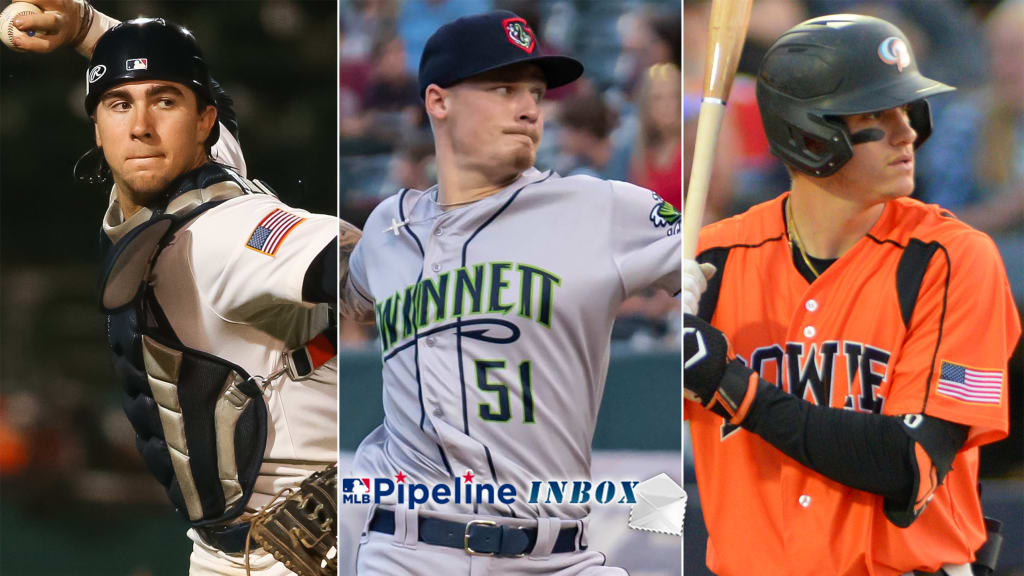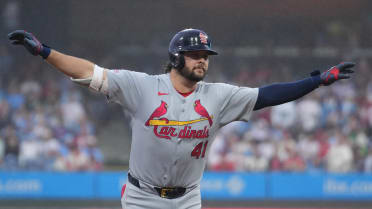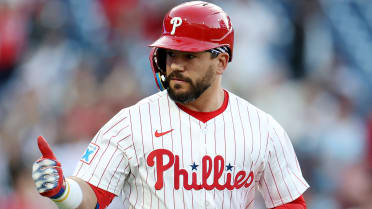
This is the third year the MLB Draft will be held in July, in conjunction with the All-Star festivities. The spotlight the Draft gets is great and the buzz in Seattle will be outstanding, but it’s amazing how old habits die hard. As the calendar flips to June, it’s like a baseball season circadian rhythm kind of thing, and I keep thinking the Draft is coming in the next week or two.
Alas, we have to wait a bit more for the start of the 2023 Draft, on Sunday, July 9. Luckily, we have plenty of Draft-related content to keep all of us busy, including our recently expanded and updated Top 200 prospects list. And we’ll keep answering all of your questions, Draft or otherwise.
I’ll kick off this week’s MLB Pipeline Inbox with a Draft question before turning to some queries on professional prospects.
Hi Jonathan! Looking at the updated top 200 and high school catcher Blake Mitchell is now ranked at 13. What aspects of his game would cause front office executives to look past the very risky high school catcher demographic to draft him in that area of the board? -- @caseywsox
Hi Ed! (@caseywsox is regular contributor Ed Casey) We do indeed have Blake Mitchell at No. 13, but lest people interpret it wrong, that’s not new. He actually was in the same spot both in the Top 100 we put out last December and the Top 150 that was released earlier this spring.
That, of course, is not the crux of your question. After high school pitchers (particularly right-handers), prep catchers are considered to be the biggest risk demographic in any Draft class, and you might even find some evaluators who think high school backstops are the riskiest bet of all. For every Joe Mauer there’s been, there have been several Kyle Skipworths or Styker Trahans. (Side note: I wonder if that will change if baseball ever moves fully to an ABS system, taking away one thing young catchers would have to worry about, framing.)
Mitchell, however, brings a few things to the table that might give some skittish clubs the intestinal fortitude to roll the dice on the demographic. The biggest is his bat, and he’s a left-handed hitter (Raise your hand if you’ve heard us talk about the left-handed hitting catcher being a very highly coveted asset), one who has every chance to hit for average and power. He’s done it against good pitching, on the summer showcase circuit and in international competition. He’s pretty much performed everywhere he's been.
Often, there are high school catchers who can really hit, but there’s uncertainty about their defensive chops. Not so with Mitchell. He’s athletic and agile behind the dish, and he can receive and block well with an absolute hose for an arm, one that fires 97-mph fastballs from the mound (providing a potential backup plan if all else fails). He also is athletic enough where he could handle moving to an outfield corner if needed. But most feel that won’t be needed, giving him every chance to buck the trend in this risky category.
What is the perception of AJ Smith-Shawver? Is he close to top 100? -- @DRByrd3
Things in the baseball world can get outdated in a hurry! We answered this question on this week’s MLB Pipeline Podcast, recording it on Tuesday morning. The timing is important.
On the pod, we talked about how impressive Smith-Shawver had been this year, how his fastball had been averaging north of 95 mph and touching 98 to go along with a plus slider and improving curve. The Braves had surprisingly put him on the fast track, after being cautious with him in his first full season in 2022, the first year he focused on baseball only (He was a very good high school quarterback.). He had gone from High-A to Double-A to Triple-A in the span of less than two months and seven total starts and had shown the ability to get outs at all three levels. We even brought out our chant: “Update the ETA!”
And I did, moving it from 2025 to 2024… until he got called up to the big leagues Tuesday afternoon. So now his ETA is 2023 and he’s looking to make his Braves Major League debut at age 20. Even before the promotion to the highest level, he was very much on our Top 100 radar and we might add him if/when we need someone new, and if we can add him before he graduates from prospect status.
With the Orioles having a stacked farm system (congrats on Coby Mayo) and having a chance to make the postseason so far, which of their Top 100 Prospects do you believe could get traded for major league help? -- @StevieDAles97
We sort of hinted at this subject when we discussed my nephew’s, I mean, the Orioles’ infielder’s addition to the Top 100. What the Orioles have been able to build under Mike Elias has been very impressive. They’re right at that point that every team hopes to reach when they need to or decide to rebuild, with a competitive team in the big leagues and a whole bunch of talent pooling at the upper levels.
There obviously won’t be room for all of them in a big league lineup and there are several areas of depth. With Mayo in mind, there are just too many infielders. We still very much believe in Gunnar Henderson and think he’ll play third regularly, with Jackson Holliday the long-term shortstop, maybe sooner than anyone anticipated. Even if Mayo moves to first, that leaves Jordan Westburg, Joey Ortiz and Connor Norby to fight it out for the second base gig? So that would be the area I would look at first should the O’s decide to be buyers on the trade market.
The second group might be in the outfield, given that normally, there’s a healthy Cedric Mullins and Austin Hays soaking up two-thirds of the playing time now. Then there’s Colton Cowser and Heston Kjerstad waiting in the wings… something will have to give, right? And even better news for Orioles fans on the prospect front is that even if they do trade away some of those Top 100 guys, there’s depth at the lower levels ready to step up.
Jonathan Mayo is a reporter for MLBPipeline.com. Follow him on Facebook and @JonathanMayo, and listen to him on the weekly MLB Pipeline Podcast.




